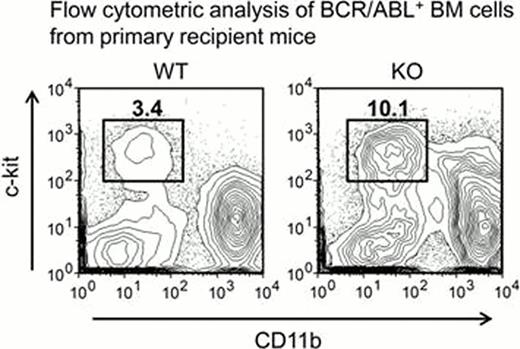Abstract
Abstract 907
Enhanced proliferation and differentiation of myeloid cells are features common to emergency granulopoiesis and chronic phase of chronic myeloid leukemia (CP-CML). We have previously shown that C/EBPβ, a transcription factor regulating emergency granulopoiesis, is upregulated in hematopoietic stem/progenitors in CP-CML and that C/EBPβ promotes BCR-ABL-mediated myeloid cell expansion (ASH annual meeting abstract. 2011; 118: 3747). However, the molecular mechanisms involved in the upregulation of C/EBPβ and the effects of C/EBPβ on the CML stem cells remained to be elucidated. Here we show that STAT5 is involved in the BCR-ABL-mediated C/EBPβ upregulation and that C/EBPβ accelerates the exhaustion of CML stem cells.
In order to investigate the regulation of C/EBPβ in CP-CML, BCR-ABL gene was retrovirally introduced into EML cells, a mouse hematopoietic stem cell line, to make EML-BCR-ABL. The expression of C/EBPβ was upregulated at mRNA and protein level in EML-BCR-ABL when compared to EML cells transduced with a control vector. The upregulation of C/EBPβ was significantly repressed by adding imatinib mesylate, suggesting that the downstream signaling pathway of BCR-ABL is directly involved in the process. Neither a PI3K inhibitor nor a MEK inhibitor affected the levels of C/EBPβ in EML-BCR-ABL, but a STAT5 inhibitor reversed the upregulation of C/EBPβ in EML-BCR-ABL. Retroviral transduction of dominant-negative STAT5 mutant also impaired the upregulation of C/EBPβ in EML-BCR-ABL. Transduction of constitutively-active STAT5 mutant into parental EML cells significantly upregulated C/EBPβ expression. These results suggest that BCR-ABL upregulates C/EBPβ expression at least in part through activation of STAT5.
To clarify the role of C/EBPβ in the regulation of CML stem cells, BCR-ABL-transduced bone marrow (BM) cells from C/EBPβ knockout (KO) mice or wild type (WT) mice were serially transplanted into irradiated recipient mice. In the first round of transplantation, all the recipient mice developed myeloproliferative status and the mice transplanted with BCR-ABL-transduced C/EBPβ KO BM cells survived longer than the mice transplanted with BCR-ABL-transduced WT BM cells. Interestingly, the frequency of c-kit+ cells within BCR-ABL+ cells was higher in the BM of the mice transplanted with BCR-ABL-transduced C/EBPβ KO cells than in the BM transplanted with BCR-ABL-transduced WT cells (Figure). When 2 × 106 BCR-ABL+ BM cells from primary recipient mice were transplanted into sublethally irradiated secondary recipients, all the mice developed a myeloproliferative status. Transplantation of 1 × 106 BCR-ABL+ BM cells from primary recipient mice, four out of the five recipient mice that transplanted with BCR-ABL-transduced C/EBPβ KO BM cells developed a myeloproliferative status and only one out of the four recipient mice that transplanted with BCR-ABL-transduced WT BM cells developed a myeloproliferative status. Transplantation of less than 0.5 × 106 BCR-ABL+ BM cells engrafted none of the secondary recipient mice. The frequencies of leukemia-initiating cells in BM of primary recipient mice that transplanted with BCR-ABL-transduced WT cells or BCR-ABL-transduced C/EBPβ KO cells were 1 in 1,404,129 and 1 in 683,773, respectively. These findings suggest that C/EBPβ promotes exhaustion of CML stem cells.
In conclusion, these results suggest that C/EBPβ is upregulated by BCR-ABL at least in part through STAT5 and that C/EBPβ has the ability to exhaust CML stem cells. We are currently investigating the molecular mechanisms which protect CML stem cells from C/EBPβ-mediated exhaustion for complete eradication of CML stem cells in the future.
No relevant conflicts of interest to declare.
Author notes
Asterisk with author names denotes non-ASH members.


This feature is available to Subscribers Only
Sign In or Create an Account Close Modal